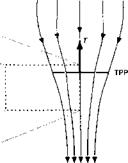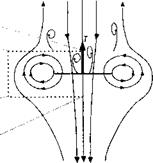Four Working States of the Rotor in Axial Flight
A description of the four working states of the rotor were first put forward by Lock and his colleagues (1926,1928) and are summarized by Glauert (1935) and Hafner (1946). Figures 2.18 and 2.20 show the lines representing Vc + u* = 0 and Vc + 2i>; = 0. Johnson (1980) shows that these lines are best used to help demarcate four axial operating states of the rotor. For points above the line Vc + vL = 0, the rotor is absorbing power supplied from the rotor shaft. Below this line, the rotor is extracting power from the relative airstream, which does work on the rotor shaft. To help understand the complicated physical nature of the rotor wake under these conditions, Fig. 2.21 shows flow visualization images of
![]()
|
|
|
|
 |


the wake at various descent velocities. Unlike some of the earlier work by Lock (1928) where smoke was used to visualize the gross flow structure, the individual blade tip vortices were rendered visible here by means of shadowgraphy, which is a density-gradient method (see Section 10.2.3). Because the flow is nominally axisymmetric, only one side of the rotor is shown for clarity.
1. Normal Working State: Figure 2.21(a) shows an image of the flow in the normal working state. Here, the tip vortices follow smooth helicoidal-like trajectories. The flow is highly periodic with a smooth slipstream boundary free of any significant disturbances. A schematic of the mean flow is also shown. The normal working state encompasses climb, with the limit being the hover condition.
2. Vortex Ring State: For low rates of descent, the tip vortex filaments are convected closer to the plane of the rotor than for the hover case, but they also move radially outward away from the rotor. At higher descent rates, the tip vortices come very close to the rotor plane and considerable unsteadiness (aperiodicity) becomes apparent. This can be seen in Fig. 2.21(b) by the contortions in the tip vortex trajectories and the lack of any distinct slipstream boundary. This is close to the flow condition known as the vortex ring state, where the accumulation of tip vortices in the rotor plane begins to resemble a concentric set of vortex rings.
3. Turbulent Wake State: As the descent velocity increases further, the wake above the rotor becomes more turbulent and aperiodic and is representative of the flow conditions known as the turbulent wake state. This state is shown by Fig. 2.21(c) and represents the initial return to a smooth flow with a well-defined slipstream boundary. The flow is similar to that associated with a bluff body.
4. Windmill brake State: At even higher descent velocities, the wake is again observed to develop a more definite slipstream boundary that expands downstream (above) of the rotor. When in this state, the vortical wake structure is found to return to a more regular helical structure, as shown by Fig. 2.21(d). As previously described, this flow condition is known as the windmill brake state because the rotor extracts energy from the flow and brakes the flow velocity like a windmill.















